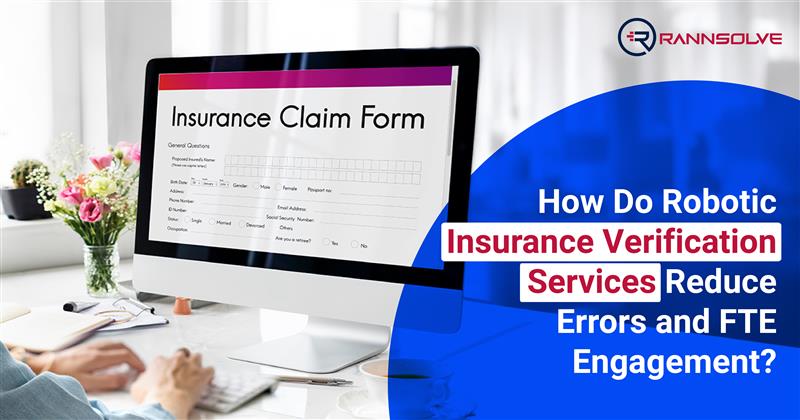Insurance verification is one of the most important steps in getting claims processed correctly. Whether you’re in healthcare, finance, or any other field dealing with insurance, the accuracy of this step affects everything that comes after. If anything goes wrong, the whole billing chain starts to wobble, causing claim denials, delays, or unnecessary corrections that eat up the time of Full-Time Equivalent (FTE) resources.
That’s where insurance data entry services make a difference. By reducing the burden on internal teams and bringing in structure, claims data entry services help minimize errors that often go unnoticed until they become problems. Although today, artificial intelligence services and solutions have made insurance data entry services much easier, a human in the loop is always necessary to validate the details. Claims data entry service providers are increasingly using AI to increase efficiency and reduce errors. In this blog, we’ll look at 8 ways healthcare insurance verification services reduce errors.
1. Automated Data Entry
Manual data entry is one of the most common sources of error in healthcare insurance verification. It only takes a misplaced digit or a wrong date for a claim to get delayed or denied. People make mistakes, especially when they’re overworked or multitasking.
Automated insurance data entry services, powered by artificial intelligence services and solutions, remove this step almost entirely. Information is extracted directly, reducing the risk of typing errors, missing fields, or inaccurate records. Tools like OCR (optical character recognition) help extract details from scanned documents with high accuracy. Artificial intelligence services and solutions ensure the system records what’s actually on the document, not someone’s best interpretation of it.
2. Real-Time Verification
In the traditional setup, insurance data entry services meant calling the concerned person or going through online portals manually to enter data. These back-and-forth processes often delayed appointments and billing, especially when discrepancies surfaced late in the process.
With real-time claims data entry services, details are checked instantly against medical insurance databases. You’ll know up front if a policy is active, what it covers, and whether it covers the particular. If there’s a mismatch, it’s brought to attention early, before any forms are filled out or procedures begin.
One of the most common causes of billing errors is incorrect or outdated eligibility information. Real-time insurance verification services solve that by confirming everything before the patient even arrives.
3. Elimination of Duplicate Claims
Duplicate claims can lead to claim denials or even trigger potential red flags with healthcare insurance companies, apart from all the time spent on manual work. These errors often happen when the same data is entered multiple times or even when teams lose track of pending claims.
Claims data entry services help flag potential duplicates before they get submitted. The system checks existing records to see whether the claim is already in progress or has been processed. This small step in insurance data entry services saves significant effort on follow-ups, corrections, and resubmissions. Claims data entry services also keep internal reporting up-to-date and easier to audit.
4. Verifying Coverage Details
Healthcare insurance plans and policies vary from company to company. While one plan might cover a treatment fully, another requires a copay, a deductible, or pre-authorization. Verifying these details isn’t always straightforward.
With medical insurance verification services, you can confirm what’s covered, what’s not, and what the patient may owe out-of-pocket. It’s a level of detail that helps billing teams send accurate invoices and reduces the number of calls from confused patients asking why they were charged.
5. Improving Claims Accuracy and Ensuring Accurate Pre-Authorizations
Incorrect medical insurance details are one of the most frequent reasons claims are denied. Missing policy numbers, outdated member IDs, or inaccurate coverage data can all lead to rejections. Healthcare insurance data entry services double-check these fields before the claim is sent out. That level of front-end accuracy reduces back-end issues for billing teams, who otherwise have to chase down errors after they’ve already caused problems.
Pre-authorizations are another common stumbling block. If approval for a procedure isn’t obtained in time or isn’t obtained at all, the claim might get denied even if everything else is correct. Insurance data entry services help manage this part as well. Claims data entry services track what requires pre-approval, make sure the right forms are submitted, and follow up with insurance companies if needed. That way, the procedure can move forward without unexpected holdups.
6. Reduced Manual Review
Manual review is slow and, ironically, still vulnerable to human error, especially when people are juggling other responsibilities. Healthcare insurance verification services take a large portion of that work off your team’s plate. Artificial intelligence services and solutions handle the bulk of the checks, while flagged issues can be escalated to people when necessary. This level of automation reduces pressure on staff, lowers error rates, and speeds up the overall process. When employees aren’t buried under verification work, they’re able to focus much better on patient care or other high-value tasks.
7. Error Notifications and Alerts
Sometimes the best way to prevent an error from snowballing is to identify it in real time. Many claims data entry services come with alert systems that notify of inconsistencies the moment they’re found. The immediate feedback loop helps teams fix issues beforehand. It helps patients receive accurate cost estimates and billing statements the first time, leading to patient satisfaction and better communication.
8. Improved Compliance with Regulations
In healthcare, HIPAA sets strict standards for how patient information should be handled. Other sectors have their own frameworks to follow.
Insurance verification services help maintain compliance by tracking regulatory requirements and applying them consistently. Insurance data entry services also ensure sensitive data is handled appropriately and kept up to date.
Rannsolve: Your Trusted Partner for Medical Insurance Verification
With over 25 years of experience supporting healthcare facilities and 8 years offering artificial intelligence services and solutions. We’re known for reliable and accurate insurance verification services. Our claims data entry services experts manage the entire process, from when a patient schedules an appointment to the moment your payment is secured.
Ready to simplify your healthcare insurance verification? Get in touch with us today!
FAQ
Insurance verification ensures patients’ coverage details are accurate before treatment begins. By using insurance data entry services, healthcare providers can prevent claim denials, delays in billing, and loss of revenue.
Insurance verification services confirm active policies and coverage terms. Claims data entry services help reduce administrative errors, ensuring claims are processed smoothly for timely reimbursements.
KYC (Know Your Customer) identifies a person’s credentials, while insurance verification confirms coverage and eligibility. Insurance verification services focus on validating policy details to streamline claim approvals.
Eligibility verification through claims data entry services improves both cash flow and patient satisfaction in healthcare operations by minimizing claim denials, confirming patient benefits beforehand, and ensuring claims are billed accurately.





